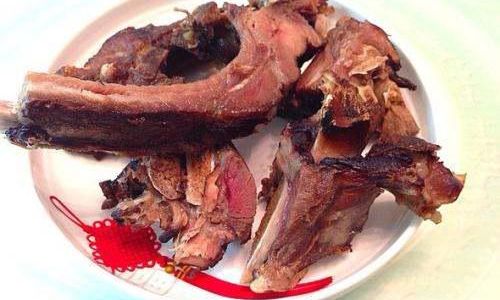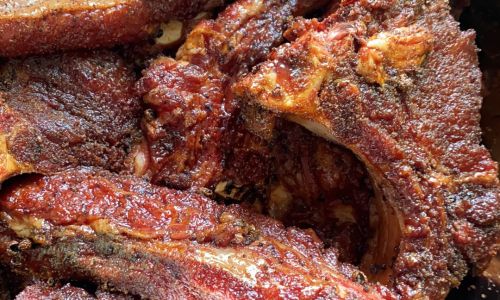Making delicious preserved pork ribs, or “la pai gu” as it’s known in some Chinese dialects, is an art that combines tradition with modern culinary techniques. This dish, characterized by its savory, umami-rich flavor and tender texture, is a staple in many households during the colder months. Preserving pork ribs not only extends their shelf life but also intensifies their taste, making them a perfect addition to various meals. In this guide, we’ll walk you through the step-by-step process of crafting mouthwatering preserved pork ribs that will leave your taste buds yearning for more.

Understanding the Basics of Preservation
Before diving into the recipe, it’s crucial to grasp the fundamentals of preserving meat, especially pork ribs. Preservation techniques primarily aim to prevent bacterial growth and extend the shelf life of food. Traditional methods for preserving pork ribs involve salting, drying, smoking, or a combination of these. Modern approaches might also incorporate vacuum sealing and refrigeration for safer, longer-lasting preservation.
For our purposes, we’ll focus on a traditional salt-drying method, which not only preserves the meat but also enhances its flavor through the process of osmosis, where salt draws out moisture and concentrates flavors.
Ingredients and Tools
Ingredients:
- Fresh pork ribs (preferably pork spare ribs), about 2-3 kg
- Coarse sea salt or kosher salt, approximately 5-6 tablespoons
- Sugar, 2-3 tablespoons (optional, for balance)
- Sichuan peppercorns, 1 tablespoon (optional, for a spicy-aromatic twist)
- Star anise, 2 pods (optional, for added depth)
- Garlic cloves, 5-6 (sliced thinly)
- Ginger, a small piece (sliced thinly)
- Shaoxing wine or dry sherry, 3-4 tablespoons (optional, for added flavor)
- Dark soy sauce, 2-3 tablespoons (optional, for color and taste)
- White vinegar, 1 tablespoon (optional, for tenderizing and preserving)
Tools:
- Large mixing bowl
- Clean cloth or paper towels
- Wire racks
- Large tray or baking sheet lined with parchment paper
- Clean, airtight containers or vacuum-seal bags
- Weights (like heavy books or a clean brick wrapped in cloth)
- Refrigerator or a cool, dry place for drying
Step-by-Step Guide
Preparation of Pork Ribs:
Start by selecting high-quality fresh pork ribs. Trim any excess fat if desired, but remember that a bit of fat can add to the flavor and moisture during preservation. Rinse the ribs thoroughly under cold running water to remove any blood or impurities. Pat them dry using clean cloth or paper towels.
Marinating the Ribs:
In a large mixing bowl, combine the coarse sea salt, sugar, Sichuan peppercorns, and star anise if using. Mix well to ensure an even distribution of spices. Add the sliced garlic and ginger. Create a paste-like consistency by adding a bit of the Shaoxing wine or dry sherry and dark soy sauce if you’re using them. The wine and soy sauce will add complexity to the flavor profile while also acting as natural preservatives.
Rub this mixture evenly all over the pork ribs, ensuring every surface is well-coated. This process is crucial for flavor infusion and preservation. Let the ribs marinate in the refrigerator for at least 4-6 hours, preferably overnight, to allow the flavors to penetrate deeply.
Drying the Ribs:
After marinating, remove the ribs from the refrigerator and let them sit at room temperature for about 30 minutes to an hour. This helps to bring the meat to a more consistent temperature before drying, which aids in even drying and flavor development.
Place the ribs on wire racks set over a large tray or baking sheet lined with parchment paper. Make sure the ribs are not touching each other to allow for even air circulation. If you have a fan or dehumidifier, positioning it nearby can expedite the drying process.
Cover the ribs loosely with a clean cloth to protect them from dust and pests while still allowing air circulation. Place the setup in a cool, dry place away from direct sunlight. Alternatively, you can use a refrigerator with the door slightly ajar to create a dry, cool environment.

The drying process can take anywhere from 3-7 days, depending on the humidity, temperature, and the thickness of the ribs. The goal is to achieve a tacky, slightly firm texture on the surface of the meat. It should not be completely dry and hard but rather have a slightly moist interior due to the marinade.
Optional Smoking Step:
For an additional layer of flavor and preservation, you can smoke the ribs for a few hours. Use a smoker or set up a makeshift smoking arrangement with wood chips or sawdust on a grill. Applewood, cherry, or oak are great choices for a mild, aromatic smoke.
Place the dried ribs on the smoker rack and smoke them at a low temperature (around 150-175°F or 65-79°C) for 2-4 hours. Monitor closely to prevent over-smoking, which can make the ribs too bitter.
Final Preservation:
Once the ribs have reached the desired level of dryness and flavor, inspect them carefully for any mold or discoloration. Properly preserved ribs should have a dark, glossy appearance with a firm but not hard texture.
Wrap the ribs tightly in plastic wrap or place them in vacuum-seal bags to remove any remaining air. Label the packages with the date and store them in the refrigerator for up to 2-3 months or in the freezer for longer-term storage (up to 6 months).
Cooking the Preserved Pork Ribs:
To enjoy your preserved pork ribs, you can steam, boil, or braise them. Steaming is a popular method that preserves the meat’s texture and flavor. Place the ribs in a steaming basket over boiling water and steam for about 45 minutes to an hour, or until heated through and tender.
Alternatively, you can boil them in water or a flavorful broth for about 30-45 minutes, or braise them in a slow cooker with additional seasonings like soy sauce, garlic, ginger, and star anise for several hours until tender and flavorful.
Serving Suggestions
Preserved pork ribs are versatile and can be served in various ways. They pair wonderfully with steamed rice, noodles, or stir-fried vegetables. You can also slice them thinly and use them as a topping for salads or sandwiches. Their rich, umami-laden flavor makes them an excellent addition to soups and stews.
Conclusion
Making delicious preserved pork ribs is a rewarding culinary endeavor that combines patience, precision, and a love for traditional flavors. By following the steps outlined above, you’ll be able to create a dish that not only tastes incredible but also preserves well, ensuring you have a stash of deliciousness ready for any meal. Whether you’re preserving for the winter months or simply looking to add a unique twist to your culinary repertoire, preserved pork ribs are a must-try for any food enthusiast. Enjoy the process and the delicious results!





0 comments